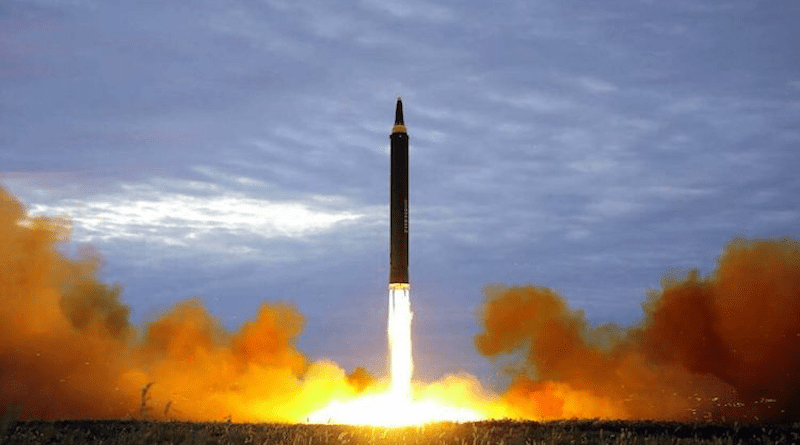On Balance: Offensive And Defensive Missile Capabilities On The Korean Peninsula – Analysis
By IPCS
By Viraj Lohia
On 31 May 2023, North Korea launched Pyongyang’s first spy satellite. The launch failed when the rocket crashed into the Yellow Sea, after veering towards South Korea. Seoul called the exercise a “grave provocation.” Washington and Tokyo also condemned it. Pyongyang vowed to conduct another launch as soon as possible.
North Korea’s recent launch is a legitimate cause for worry for South Korea, Japan, and the US. Coupled with their advanced missile technology, the satellite will hone Pyongyang’s offensive capabilities in the form of potent precision strikes. An overview of North Korea’s offensive missile and South Korea’s defensive missile capabilities is thus germane—especially as North Korean developments appear to be outpacing South Korea’s.
The North Korean Missile Threat
North Korea’s missile programme has advanced rapidly under its leader, Kim Jong Un. Today, its missiles are able to hit all of South Korea, and are difficult to intercept while being easy for Pyongyang to operationalise. The North Korean arsenal includes the KN-23/KN-24 short-range ballistic missile, which are variants of the Soviet-era Iskander missile with a range of nearly all of the peninsula.
The KN-23/KN-24 missiles fly in a quasi-ballistic trajectory and can perform pull-up manoeuvres in their terminal phase. This makes it difficult for missile defence systems to accurately calculate a point of interception. These missiles are also solid-fuel, which makes them easier to transport and faster to launch. They are tough to intercept not only because of their trajectory but also because of their shorter burn period. Detection during launch via infrared sensors is thus less likely.
North Korea is also developing hypersonic capabilities. The indigenously developed Hwasong-8 is a hypersonic glide vehicle with more manoeuvrability than the KN-23/KN-24. Greater manoeuvrability creates additional difficulties for missile defence systems to precisely intercept an incoming missile. North Korea is simultaneously testing submarine-launched and land-basedcruise missiles. These are difficult to detect due to their low-altitude flight path.
North Korea has also reportedly been working on miniaturising its nuclear warheads. On 28 March 2023, the state-sponsored Korean Central News Agency (KCNA) released propaganda photos of Kim Jong Un standing beside a device called the Hwasan-31. The report claimed that the device was a miniaturised nuclear warhead that could fit on North Korea’s short and long-range missiles.
An operational, miniaturised warhead would be a significant nuclear milestone. Further, a successful spy satellite launch would enable Pyongyang to use its arsenal for precision and pre-emptive strikes against its enemies.
South Korean Missile Defence
South Korea is spending a fortune to build a multi-layered missile defence system called the Korea Air and Missile Defence (KAMD). The first layer of this large system is formed by the American-made PAC-2/PAC-3 air defence systems. Cheongung II, an indigenous system, forms the second layer. The US’ Terminal High Altitude Area Defence (THAAD) forms the top layer. These systems intercept incoming missiles at altitudes of 20 km, 40 km, and 150 km, respectively. South Korea also intends to run ballistic missile early warning systems on Aegis destroyers to strengthen “all-directional” detection capabilities.
Over the past two years, South Korea has been upgrading parts of the KAMD. In early 2022, Seoul announced plans to upgrade its existing PAC-2 systems to PAC-3. In the middle of the year, along with raising overall defence expenditure, it also budgeted for more PAC-3 missiles. In December 2022, the country received PAC-3 systems and missiles as part of a capability enhancement programme with the US.
Upgrading the short-range layer of the KAMD appears to be most important. This is because PAC-2-capable missiles employ blast fragmentation technology, which is not as reliable as the hit-to-kill technology employed by other systems. Blast fragmentation doesn’t completely destroy the warhead—even in a damaged state, the warhead could still hit near the point of interception. Hit-to-kill missiles, on the other hand, ensure complete destruction mid-air.
South Korea has also been developing its own long-range surface-to-air missiles (L-SAM). These missiles are capable of high manoeuvrability during the terminal phase of an engagement which directly counter Pyongyang’s new, manoeuvrable missiles. The L-SAMs are scheduled to be deployed by 2027. Lastly, South Korea’s Defense Acquisition Program Administration plans toinduct another range of advanced L-SAMs (and medium-range SAMs) between 2024 to 2035 to defend against advanced North Korean hypersonic and inter-continental ballistic missiles.
The new L-SAM project comprises the development of a gliding-stage interceptor missile tocounter North Korean hypersonic missiles. The M-SAM project is aimed at improving interception performance. Since THAAD is inoperative against the KN-23 and PAC-3, and Chenogung II systems can’t accurately calculate interception courses, these developments would fill current gaps in the KAMD.
Conclusion
Even though South Korea has accelerated its missile defence upgrades, they don’t seem to be keeping pace with North Korea’s growing offensive capabilities. For instance, the upgraded KAMD could take up to four years to materialise. Other systems might take up to a decade to even be developed. That being said, despite its own defence shortcomings, South Korea does fall under the US’ nuclear umbrella. For the time being, the US’ recent reaffirmation to use all capabilities, including nuclear weapons, in case of a North Korean attack, should be an effective deterrent.
Viraj Lohia is an intern at the Institute of Peace and Conflict Studies.

